By Jeffrey A. Rendall, Photos By Jeff Janas
WOODBRIDGE, VA -- Believe only half of what you see, and none of what you read. This assertion may be the ultimate pessimistic anthem, but when it comes to the Ospreys Golf Club at Belmont Bay, they're words to live by. At first perusal of the scorecard, you'll no doubt note the course measures only 5567 yards from the back tees, yet plays to a par of 70. Immediately 'executive course' pops into your head, and you start taking all your woods and long irons out of your bag.
Don't do it. Looks (and a scorecard's printing) are often deceiving, and that's never more true than for this tricky little target golf course set alongside the banks of the Occoquan River in Woodbridge, Virginia. Despite its short yardage, the layout will test all the golf skills you bring with you (including driving distance), and you'll need to leave every club in the bag for the trip around the links -- and use them effectively, too.
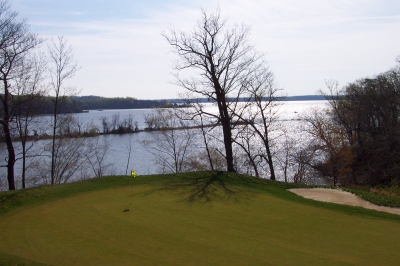 |
| The 16th green isn't right on the water, but the fact that almost everything but the green means a lost ball certainly makes it feel like an island. |
Yard for yard, the Ospreys might be the toughest course in Northern Virginia. There are very few holes where there isn't something threatening on every shot -- and on most links, there's more than one challenge to overcome. The course lies in and around wetlands, woods, ponds, deep ravines and the Occoquan river -- and when you throw in the manmade golf hazards of bunkers and fast greens -- you've got more than enough to contend with.
Further, because of the course's exposed presence along the river, wind is often a factor. When you play at the Ospreys, ignore the scorecard yardage figures and try to keep your thoughts on where the ball needs to go. Pay particularly close attention to hazard locations and wind direction, then fire away. The layout is the ultimate placement golf course.
It's also the antithesis of the grip it n' rip it adventure. There are certainly several holes where there's reasonable room for error off the tee, but if you're in trouble, in most cases you're dead. Charity events collecting fees for penalty strokes would do very well here.
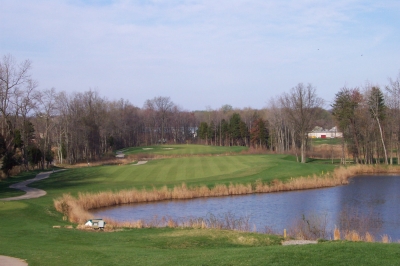 |
| The 10th hole is a good example of the challenge at The Ospreys -- not overly long, but a carry off the tee, a carry into the green, and not much room to miss on either side. |
Despite the tight nature of the track and its considerable challenge, it's an enjoyable golf round. If you play within your game and hone your club selection, you'll have a reasonable opportunity to score well -- after all, the longest hole at the Ospreys measures only 487 yards (a par five). If you're accurate, there will be scoring chances. Take them when they come -- you'll need some to make up for the times when your ball disappears into an abyss.
Doug Walczak, the Ospreys' Head Pro, says scale, not lack of difficulty, is what separates the course from its longer, more traditional siblings. "Our course isn't real long, but what it lacks in yardage it makes up for with tight fairways, fast greens and creative bunkering -- it's very much of a shotmaker's course. You just can't just go flailing away with a driver here, because you're gonna end up off the track."
Walczak also points to the course's conditioning as a good reason to visit. "We have all bent grass tees, greens and fairways. Our greens are very fast -- they normally run about a nine on the Stimpmeter, and during the high season, are almost always in excellent shape." That's certainly no exaggeration -- there's very little to complain about in terms of grounds neglect or lack of greenery.
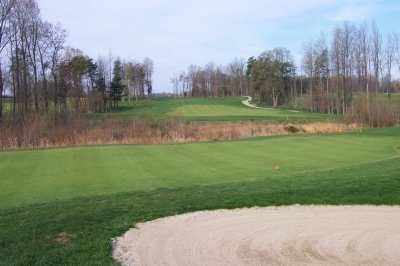 |
| You'll see lots of wetlands at The Ospreys, and quite a bit of wildlife, too. |
And based on our experiences, you'll probably get to see all the conditions up close from many different angles. It's a good thing the starter sends everyone off the first tee with some 'suggested' placements on each hole, because without them, first timers won't have a clue. Great length is not required from the tee box, but approximate yardage is -- and the guide helps immeasurably.
The round begins with a 172 yard, slightly downhill par three -- with a lake short and to the left. The shot suggestion guide neglects to mention a huge oak tree that also guards short and left, but you'd have to be sightless to fail to notice that obstacle. Needless to say, avoid it. There is considerable bail out room to the right, but losing it in that direction will leave you a treacherous downhill chip to try and save par.
The course then takes a half-mile detour to a relatively flat and marshy patch of ground, with a mixture of tree-lined fairways and open space covering the next twelve holes. Here is where several changes were made to the course four years ago, stretching the layout from a par 66 to its current par 70 arrangement.
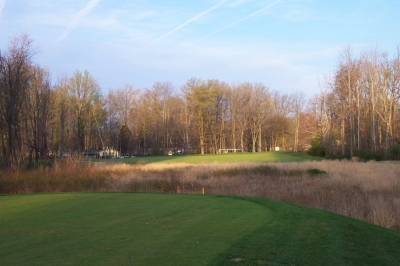 |
| The 'new' tee box on the 3rd hole made it into a severe dogleg left par four. |
Briefly, new tees were added to stretch the third hole from a par three to a par four; the fourth hole (par four) was newly added; the old fourth (new fifth) hole received a new set of tee boxes farther back, lengthening it from a par four to a par five; and the old sixth and seventh holes were combined to create another par five (sixth). The changes made are seamless to the eye -- even to someone who never saw the course prior to its metamorphosis. The only sign of the old layout that still exists is an abandoned green on the right side of the fairway along the sixth hole.
The Ospreys' eighth hole would fit in well at any regulation length course. Measuring 412 yards from the back, it plays mostly uphill and often into the prevailing wind. From the back tees, it's a 190 yard carry over an environmentally protected wetlands area, leaving a mid to long iron to the elevated, severely sloping green for your second shot. Quite challenging.
The ninth hole is a picturesque 182 yard par three, also into the wind, protected by a lake on the right and a bunker on the left. Short is okay, as there's a false green in front -- which leaves a relatively easy pitch up the slope if you didn't tee with enough club.
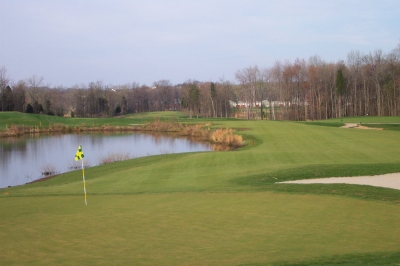 |
| The 6th hole is one of the shorter par fives you'll likely ever see, but you'll still think par's a decent score after you play it. |
Holes ten through thirteen continue through a mixture of open space and trees, and what seems like a constant threat of water or wetlands on every tee shot. This stretch would seem to favor a high ball flight, but then you're contending with wind. Again, precise shotmaking is the key.
Holes fourteen through eighteen parallel the Occoquan river -- and it's more than just pretty scenery. The course is laid on top of a high bluff, and any shot hit to the right will certainly end up down where you can't get to it.
Sixteen is the most intriguing 125 yard par three you’ll probably ever see. In between the tee boxes and the green is a deep ravine. In back of the green to the center and left is a steep hillside covered with thick grass and brush. To the right is the river. The only bailout possibility is long and left, but that's the direction the wind usually blows from. The green is fairly large for such a short hole, but this is trifling compensation for all the trouble abounding.
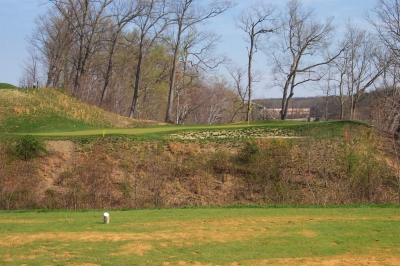 |
| In this early spring photo, you can't garner just how deep the ravine is between the tee and green at the 16th hole -- but it's a long way down. |
Seventeen is 429 yard par five, and the second shot is severely downhill. Easy eagle try, right? Not so fast. First off, you'll realistically get only 210 yards off your tee shot -- again, which plays into the wind (taking a long iron or three wood). If your tee ball isn't long enough, the second shot's blind down the severe slope, and there's trouble all around the green. Par's not such a bad score here.
The round concludes with a straight uphill par three of only 121 yards, but club selection and wind direction will determine how close you get to the flag for a final birdie try.
It's fitting the last hole has a semi-blind tee shot, and that even a short hole can be deceptively difficult. But that's true for virtually all of the Ospreys' layout. It'll certainly make you remember that looks can often be deceiving -- and in some cases, that's not so bad, either.
Details:
The Ospreys at Belmont Bay
13401 Potomac Path Drive
Woodbridge, VA 22191
Phone: (703) 497-1384
FAX: (703) 497-0722
Website: www.belmont-bay.com
Head Golf Professional: Doug Walczak
| Tees | Yardage/Slope | Rating |
| Back | 5567/127 | 68.2 |
| Middle | 5214/121 | 64.9 |
| Forward | 4285/108 | 65.3 |
Rates:
Mon-Fri: until noon, $38; noon to 4:00 p.m., $32; after 4:00 p.m., $25
Weekends & Holidays: until noon, $49; noon to 4:00 p.m., $38; after 4:00 p.m, $30
All prices include cart.
| Related Links | Comments on this article? | |
|
Maryland National Golf Club Hollow Creek Golf Club Rocky Gap Resort PB Dye Golf Club in Ijamsville Whiskey Creek Golf Club |
E-mail Jeff Rendall, Editor: jrendall@golftheunitedstates.com |











